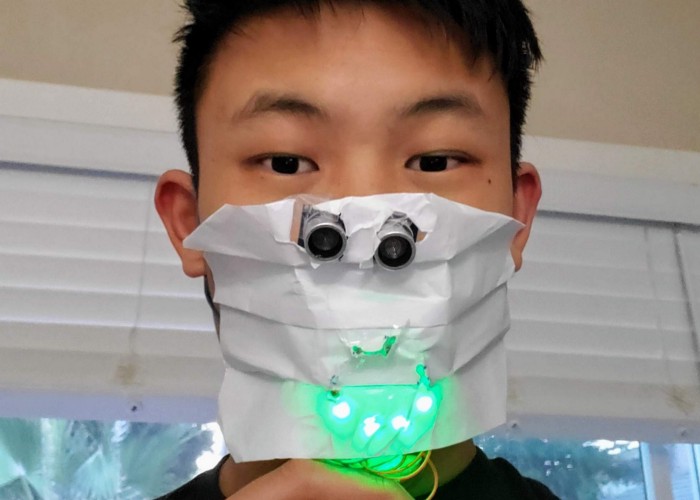
Due to COVID-19, this year’s Management & Technology Summer Institute (M&TSI), switched to remote learning for 94 dedicated high school students interested in the intersection of engineering and business. Run by the Jerome Fisher Program in Management & Technology, the for-credit summer program is for rising high school juniors and seniors and provides a unique opportunity to learn from Penn Engineering and Wharton faculty and TAs, along with a robust curriculum centered on problem solving, product development and creativity.
During this year’s remote program, students took part in a “Maskathon,” an extracurricular social event in which students spent two days developing tech-integrated face masks. They created their mask prototypes at home, using a variety of materials to upgrade simple cloth coverings with new, interactive features. Integrating electronics with everyday materials like bubble wrap and printer paper, their masks were creative and unique takes on the essential pandemic accessory. While students were not required to develop masks specifically for COVID-19, several students chose to build in features that could help stop the spread.
Maskathon requirements were simple: Students were required to combine the engineering skills they had learned during the program to create face masks that served a specific purpose. They had one day to brainstorm their ideas and another to build the circuits and complete a prototype.
Since M&TSI was conducted remotely this summer, students were sent a starter kit with an Arduino microcontroller, LED lights, sensors, motors, cables and more.
On the engineering side, M&TSI’s curriculum uses Arduino, an open-source electronics platform based on easy-to-use hardware and software, to teach students how to build prototypes of various digital devices. Arduino boards can read inputs, such as an LED light, and convert them into outputs, such as turning on the light. In the M&TSI program, students learn how to program the Arduino hardware to perform certain tasks. The program curriculum advances from learning about Arduino’s basic functions to lighting an LED, programming sensors, and finally, collecting data from sensors and sending it to cloud-based platforms. Learning Arduino is a gateway into a deeper knowledge of customizable hardwares, and M&TSI students are able to bring their ideas to life. At the end of the program, the students complete final projects that incorporate all of the skills they learned in Engineering and Wharton lectures. These projects are then shared in Technology and Product Design presentations in the final days of M&TSI.
While the Maskathon was meant to be a social event more than a competition, Leslie Birch, Laboratory Resources Coordinator for the Detkin Lab, and Kshitiz Garg, a junior in Systems Engineering and Finance at Penn and an Engineering TA for M&TSI, identified five masks that stood out based on their creativity, complexity, and product potential.
Mindful Mask: This mask measures humidity levels to alert its wearer to breathing patterns, i.e. too-shallow breaths or too few breaths in a given time frame.
Smile Masks: These two masks combine sensors and LED lights to promote social distancing. The masks light up into a human-like smile or frown to inform others of their proximity to the mask wearer.
Glowing Distance Mask: This mask uses LED lights and distance sensors to encourage social distancing. The mask lights up to signal if a person near the mask wearer is too close. The design used bubble wrap as a holder for its circuit board and as a source of LED light diffusion, which gave off a glowing effect.
Mask Alarm: This mask uses a photoresistor to sense whether or not the mask is being worn. Potential future versions of this mask could integrate phone notifications.
“The thought behind the Maskathon was that we wanted the students to consolidate what they had learned in the program so far,” says Garg. “The Maskathon was a precursor to the students’ final projects which required them to use everything they learned from Engineering and Wharton faculty to identify a problem and develop a creative solution as well as a business plan and website for the product.”
Some of the final projects included a plant stand that rotates to maximize sunlight exposure, a doormat equipped with weight sensors that alert users when a package is delivered to their doorstep, a pothole detector, and sensors to “gamify” home gardens by measuring humidity, temperature and moisture levels.
“At the end of the day, this program is all about developing entrepreneurial skills,” says Birch. “Because we were learning remotely this summer, TAs like myself and Kshitiz were more needed than ever. We were able to work one-on-one with students through Zoom and stay online with them as they troubleshot their circuits. Some students said to me, ‘We didn’t know who you were at the beginning of the program, but we certainly know who you are now!’”
With the adaptation from a residential program to a remote one, students discovered new ways to grow their engineering and business skills from home. Engineering labs were transferred online and students worked alongside TAs in Tinkercad, an online 3D design program, which allowed for thorough feedback on designs and easy troubleshooting before students built real-life hardware. Another product of remote learning was a greater emphasis on data collection and the use of cloud platforms to perform decision making.
Garg says that the adapted curriculum for M&TSI placed greater emphasis on making sure students learned how to use the data in a meaningful way.
“It was awesome to see the students collaborating on Zoom,” he says. “They hadn’t met each other in real life but they were already working together and solving real problems as a team.”
